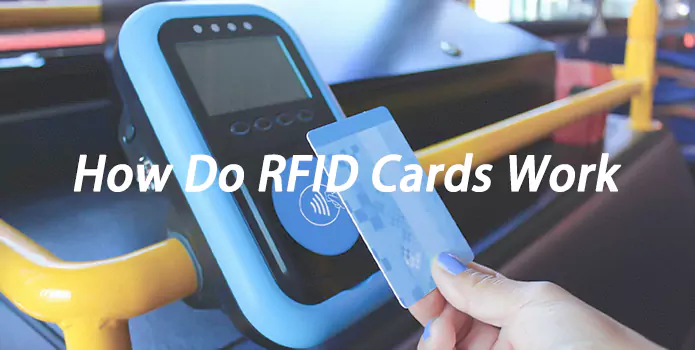How do RFID-Karten work? Well, these are smart cards that use radio frequency identification technology to transfer information. They have numerous applications ranging from contactless payments, access control, and tracking among others.
An RFID card is equipped with an RFID tag that contains encoded data. It only works when the tag is powered by an RFID reader through electromagnetic waves. This guide answers all your questions on the functionality of RFID Cards.
What is an RFID Card?
An RFID card comprises the following:
- RFID-Chip. This is the smallest component of the RFID card. It is the integrated circuit system responsible for data storage. Different types of tags come with varying memory capacities. As such, you should be keen to choose one that suits your storage needs.
- RFID-Antenne. This is a wire that sends and receives signals. It is strategically located close to the surface for optimal signal reception.
- Substrat. This component is used to hold the constituents of an RFID tag together. It is made of thin plastic material or a flexible polymer. The material is preferred due to its ability to withstand harsh environmental conditions. It offers resistance to moisture, temperature, chemicals, and impacts that can destroy the RFID tag.
An RFID card can be customized to suit your needs. It can be made using different materials and can be printed in different colors. However, you should select a substrate that can withstand your environment. This way, you will reduce the chances of RFID tag destruction.
Wie funktionieren RFID-Karten?
RFID cards use the principle of contactless data exchange. The technology is an improvement of the traditional magnetic cards that required direct contact between the card and the reader.
So, how does an RFID card work?
These cards contain an RFID chip with unique identifiers of the cardholder. When the card comes close to an RFID reader, the tag receives the reader’s signal and sends the data.
The sent data is then analyzed and compared with the identifiers saved on the controller. If the details match, the card will execute its intended purpose.
RFID Cards vs. Proximity Cards – What’s the Difference?
While both cards utilize radio waves to exchange data, there are several differences between them. They include:
- Read Range. An active RFID card has a wider read range than proximity cards (can only be read within a few centimeters). The limited read ranges limit proximity cards for applications that need a small read range.
- Storage. An RFID card can hold more information than a proximity card. As such, these only businesses that do not require large storage can use proximity cards.
- Operational Frequency. While RFID cards can operate at low, high, or ultra-high frequency, proximity cards only operate at 13.56 MHz.
- Read/ Write Features. RFID cards are read/write while proximity cards are read-only
Applications of RFID Cards
There are numerous applications of RFID cards. We outline 5 of the most revolutionary applications:
- Contactless Payment
Most businesses have automated their payment/checkout options. If you’ve visited a store and were required to wave your card to a reader for checkout, then you have experienced RFID contactless payment first-hand.
This technology uses smart credit cards such as PayWave by Visa or PayPass by MasterCard to execute the payments. The card comes with an RFID chip that links directly to your bank account. The RFID chip is not powered and will only become active when it detects signals from an RFID reader.
Here is a step-by-step guide on what happens when making contactless payments:
- Identify an RFID-Enabled Payment Terminal. Contactless payments can only occur if the store has installed an RFID reader.
- Wave Your Card In Front of the Reader. Once you get the final bill amount, all that will be required of you is to get the card close to the reader. No PIN or Password will be required.
- Check Out. Immediately after waving the card in front of the RFID payment terminal, you will get a message that payment has been successful.
However, payments can be declined for various reasons. Some of the major reasons that can contribute to this include surpassing daily bank limits or having insufficient balance in your bank account.
Since these transactions do not require PIN or Passwords to execute, a majority of the banks have set a daily limit that you should not exceed.
- Zugangskontrolle
RFID cards are also used to allow or deny access to high-security areas. In this case, you will be required to have an RFID card before visiting the premises.
The cards contain your unique identifier. When you approach the door of the given building, an RFID reader will scan the tag within seconds.
If the details contained in the card matches that in the database, you will be allowed access. If not, then the door will not open. The process of scanning and verifying the details takes seconds!
- Hotel Visitors’ Management
You can use RFID cards to track and manage visitors in a hotel. The technology helps you reduce losses as you can account for all your rooms.
An effective hotel management system starts with buying RFID cards for all your accommodation rooms. The tags are relatively affordable, and you shouldn’t worry about the cost.
However, you will also require RFID readers installed at each door, which can be expensive. This coupled with the cost of installing software to integrate your data system with the RFID system makes the initial capital high. Nevertheless, the sum benefits will outweigh the investment in the long run.
How Much Does an RFID Card Cost?
Unlike tags and inlays, RFID cards can be costly. They have a protective casing that makes them aesthetic and durable.
The price of an RFID tag will depend on various factors, including the type (active or passive), substrate material used, and aesthetics requirements. On average, active RFID cards cost $2 or more, while passive ones may cost approximately $0.15
Where Can I Buy RFID Cards?
RFID cards are available for sale in different outlets, including Amazon. Additionally, you can book a card directly from a manufacturer if you need more customization.


